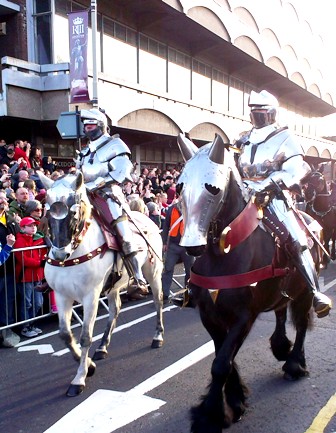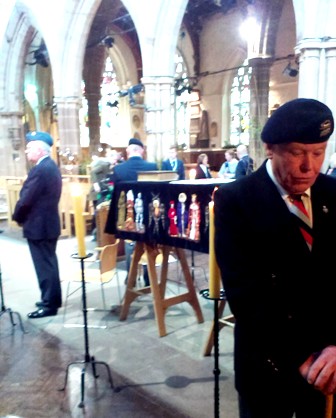
A horse at last: Richard III's cortège touring the city centre
King in a car park: the power of culture examined
The discovery of the remains of Richard III and their subsequent reburial focused considerable international attention on Leicester and gave a welcome boost to the city’s profile.
Martyn Allison explains some of the challenges that the city council faced and explores some of the lessons that have been learned.

A horse at last: Richard III's cortège touring the city centre
It is not often that you find a king in your social services car park but when you do, you can see the power that culture has to generate an amazing impact on tourism and the local economy.
I worked for the city council for 15 years, responsible first for sport and culture and latterly as assistant chief executive, and have watched the Richard III project with admiration, so when the Leisure Review asked me to share my perspective I was pleased to contribute.
Three years ago an archaeological dig in a council car park in Leicester uncovered the body of Richard III, killed on the battlefield at Bosworth and brought back to the city to be buried in the Greyfriars monastery. The story went worldwide overnight and started a media frenzy that peaked with the final interment of his remains in Leicester cathedral. Of course it helps if there is a legal challenge on the way, which you win.
Leicester is an ambitious city that has tried for many years to develop a visitor economy with some limited success. It has always been well known for its famous Tigers rugby team and the football team raises its profile once every decade by briefly getting into the Premier League but building a national tourism profile has been hard work. In 2001 millennium lottery funding was used to build the £52 million National Space Centre, which has done well to attract 250,000 visitors a year to the city. Five years ago over £60 million was invested in the new Curve theatre, which has now developed a national reputation for its productions. The Leicester Dave Comedy Festival generates a national profile for the city for two weeks every February and generates over £1 million for the city’s economy. Finally the city is well known for its many multi-cultural festivals, including the switching on of the Diwali lights, which is now one of the biggest in Europe, attracting more than 30,000 people, many from outside the city.
Culture and sport has therefore always underpinned of the city’s attempts to generate national profile and an economic impact from the visitor economy. However, nothing could have prepared us for the opportunity created by finding a king in a car park. The challenge now is harnessing and sustaining the ongoing impact of what has been created.
The events to mark the interment this week were preceded by extensive preparations and investment, supported by effective partnership working and led by a council and an elected mayor who understand the need to speculate to accumulate when opportunities arise.
The story starts with Philippa Langley and the Richard III Society who set out to convince people in Leicester to look for the king. Resources were raised to enable the University of Leicester to carry out the dig in 2012. The story of finding the skeleton in the car park was one that fascinated the media and great interest was raised by the speculation about who had been found. The search team from the University of Leicester carried out months of tests to prove that it was Richard.
The terms of the archeological licence meant that any remains found had to be interred in the nearest consecrated ground, which meant Leicester cathedral just round the corner from the dig. As the possibility that the king had indeed been found emerged, the potential impact on the city became apparent and plans were hatched to ensure the opportunity was taken but with proper dignity. After all, finding a king was one thing: burying one was something altogether different.
Before the search team had even been able to confirm that the king had in fact been found a building was acquired to house a permanent visitor centre that would be able to tell the story and accommodate the actual burial site. The site chosen was adjacent to the cathedral where the remains, if confirmed, would be laid to rest. The council planned a refurbishment programme of the area between the cathedral and the visitor centre to create a public space fit for visitors.
Meanwhile, Channel 4 were already recording the process from the beginning for a programme that was finally televised in February 2013, the night after the search team had confirmed their findings live on TV in the morning. Media interest meant that the story was now world news.
Throughout 2014 the plans unfolded and opposition to these plans grew, including a legal challenge to take the remains of Richard III back to York. After months of nervous waiting the legal challenge failed and the interment date was set for 26 March 2015.
The cathedral successfully raised nearly £2.5 million to fund the refurbishment of the cathedral, build his tomb and put on the week’s events. The council opened the new £4 million visitor centre and funded improvements at the Guildhall, another museum adjoining the cathedral. This meant that the infrastructure was in place to welcome people to the city and all that was left was to construct a programme that reflected “dignity and honour”, which was the theme for the week.
To say that we have all been surprised by the results is an understatement.
The first major event took place on Sunday 22 March when Richard was taken back to the battlefield site where he fell and from where he started his final journey back to the city. Thousands of people attended events at the Bosworth visitor centre and the route into the city; another 35,000 people lined the route through the city centre. Drawn by four horses and supported by mounted knights, the cortège toured the city centre before the remains were formally handed from the University of Leicester to the cathedral. Channel 4 covered the whole event live, along with another 150 accredited media organisations.
On Monday morning crowds queued for up to four hours to visit the coffin on display in the cathedral. This continued for three days, resulting in 20,000 people attending. On Thursday the interment ceremony was watched by thousands of people along the streets of Leicester, again with live TV coverage. On Friday the tomb was finally revealed and that evening the week concluded with a display of 8,000 flames and fireworks around the cathedral.
Throughout the week the city had been vibrant with noise and colour. Shops and restaurants all reported great business. Visitors came from America, Australia, Brazil and from across Europe. It seems that this could be a sign of things to come Within weeks of Richard being found the Dean of the cathedral was being offered busloads of American tourists. Interest is genuinely worldwide.
So what does the future hold for Leicester? Some of the national press have been a bit sceptical of the city’s efforts to maximise the opportunities despite every attempt being made to treat Richard with dignity and honour. Some local people have expressed disquiet that the council has spent money on the project while having to cut basic services; and they do perhaps have a point. However, thousands of local people have got involved across both the county and the city. Partnerships between city and county councils, universities, church and media have been built and strengthened. Even the owner of Leicester City FC has contributed £100,000 to the appeal. Areas of the city centre have been regenerated and improved, and the profile of the city has been raised throughout the world. Leicester and Leicestershire now finally have a portfolio of cultural and sporting experiences to make a viable tourism offer.
But what will be the long-term impact of the project? No doubt one of the universities will complete the economic impact study before long and we will know if the investment was worthwhile.
In conclusion, perhaps the lesson to be drawn from the discovery of Richard III is fairly simple: if you find a king in one of your car parks do not miss the opportunity. Have the confidence to back your judgments, be prepared to speculate to accumulate but above all show the leadership to make things happen.
Martyn Allison is a former national adviser for culture and sport at the IDeA/LGA, a chartered fellow of CIMSPA and chair of the CIMSPA membership committee. He is also c hair of the QUEST/NBS board. He has recently been appointed to the newly created post of the Leisure Review's royal correspondent.
The full, highly detailed story of the discovery and reburial can the Richard the Third Society web site www.richardiii.net
A flavour of the reburial events is available via YouTube footage:
The Leisure Review, May 2015
© Copyright of all material on this site is retained by The Leisure Review or the individual contributors where stated. Contact The Leisure Review for details.
![]() Download a pdf version of this article for printing
Download a pdf version of this article for printing
